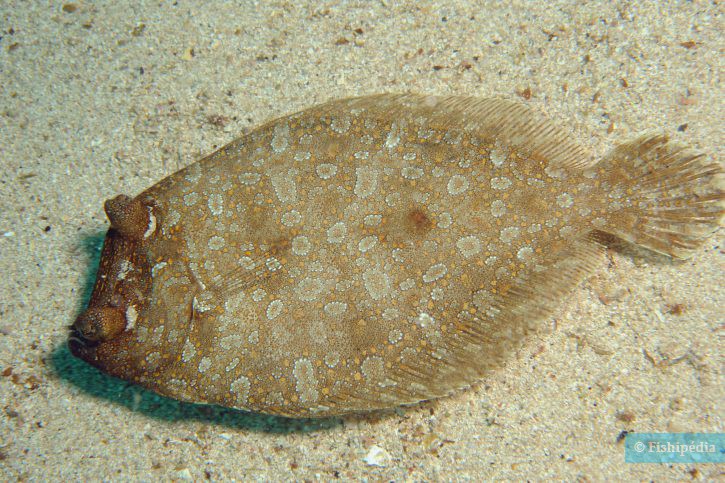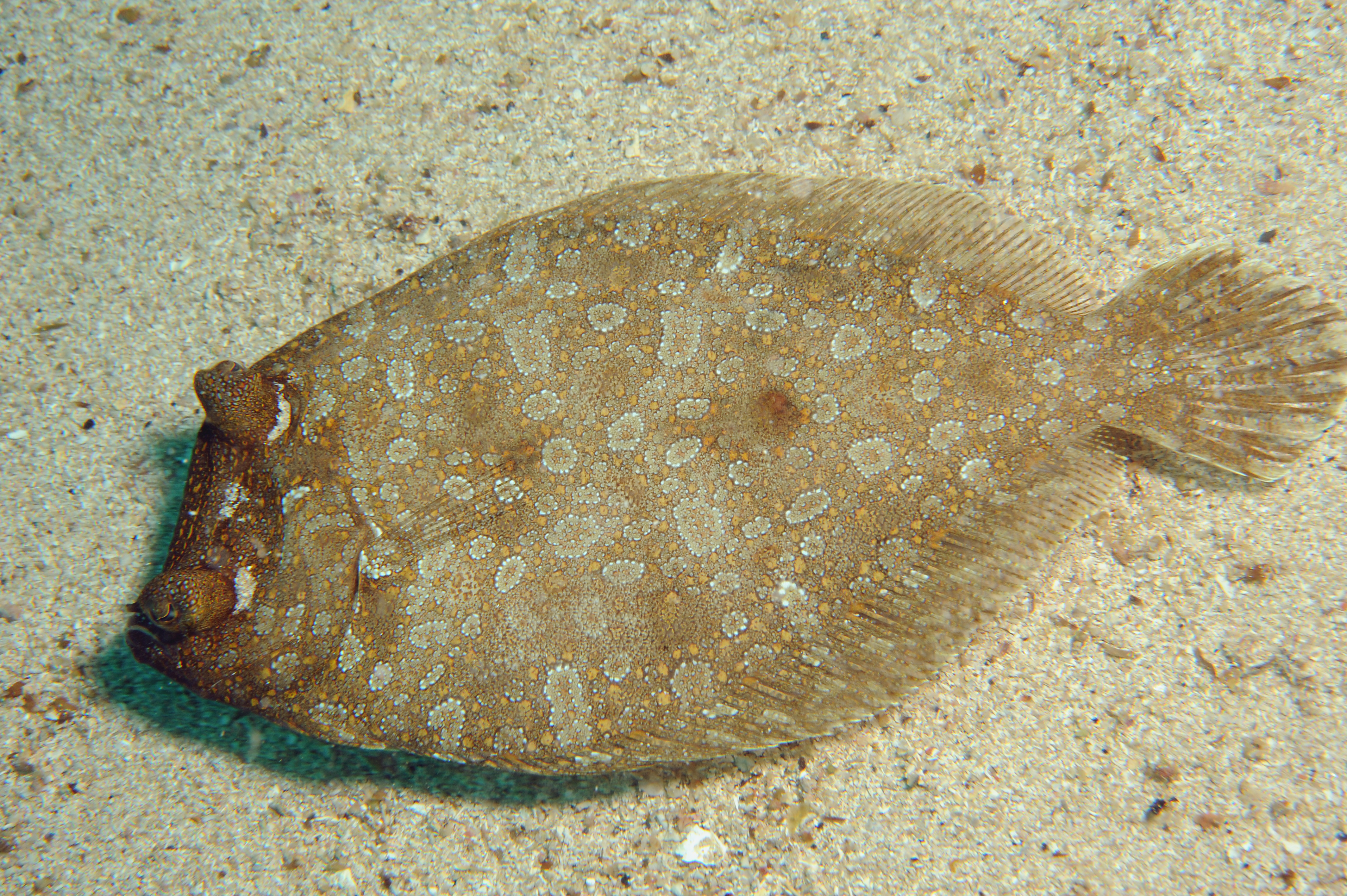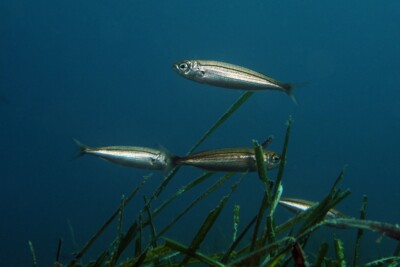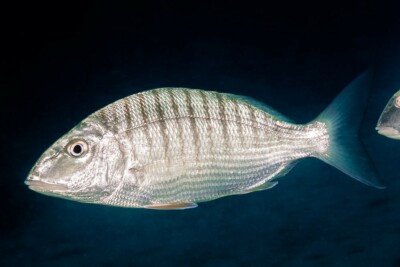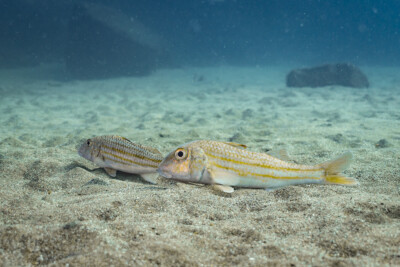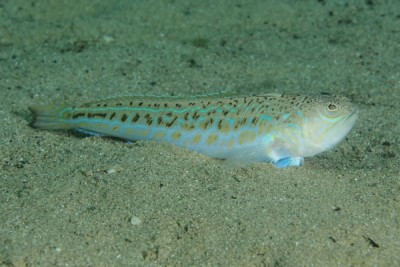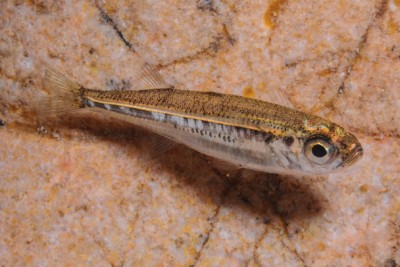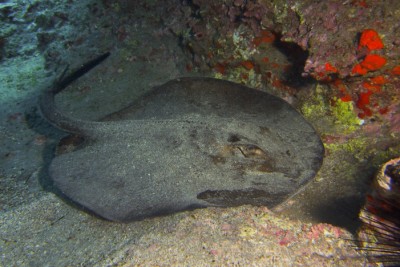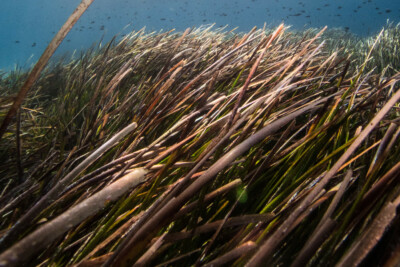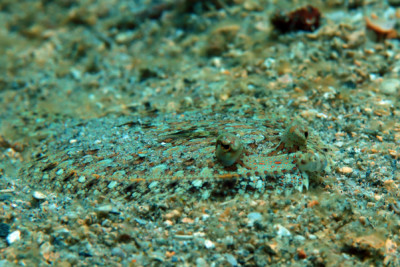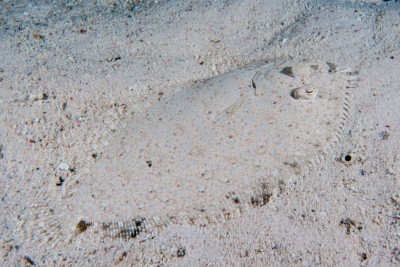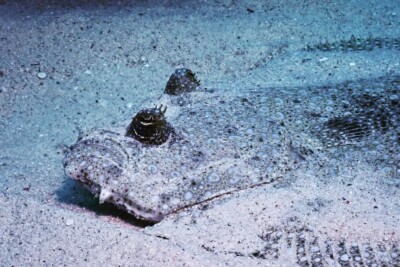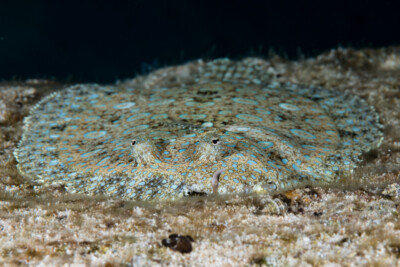Introduction
The Bothus podas, more commonly known as the wide-eyed flounder, is a flat fish living in the Mediterranean Sea and on the Eastern temperate Atlantic Ocean coast.
Who is it?
Morphology
-
Average size15 cm
-
Maximum size45 cm
-
Mimicrysand
-
Patternponctuations
-
Average size15 cm
-
Maximum size45 cm
-
Mimicrysand
-
Patternponctuations
How to recognize This fish ?
The wide-eyed flounder is a sinistral bony fish (both eyes on the same side: the left side). The scales on the ocular side are ctenoid and cycloid on the blind side. The upper rays of the pectoral fin are not elongated. The upper side is light brown, with darker spots. The Madeira and Canary Islands subspecies is dark brown to dark purple.
The wide-eyed flounder may be confused with species of the genus Scophthalmus, but it differs by its diamond shape.
Sexual dimorphism
The adult male is larger than the female. The inter-orbital width is also wider in the male.
Behaviour & Life cycle
-
dietomnivorous with carnivorous tendency
-
Sociabilitysolitary
-
territorialYes
-
Way of livingnocturnal
Males are territorial and do not tolerate competitors in their living area. They can show signs of aggression and perform muscular displays. Females are more peaceful, living in small territories that may overlap with those of males.
Territories change between day and night. It seems that males approach the shore at night while females move to deeper waters.
These fish are solitary and spend their time resting on the substrate or buried, waiting for prey, especially invertebrates and small fish. They are preyed upon by rays and sharks. When threatened, they blend in with the seabed or instantly bury themselves in the sand until the predator leaves.
They are mainly found in sandy or mixed bottoms in the Mediterranean, often near seagrass beds.
Reproduction
-
Reproductionovipare qui pond en eau libre
The wide-eyed flounder is an oviparous fish that spawns freely. Males have a harem of several females residing on their territory.
Potential partners communicate through touch using the ocular pectoral fin. After a courtship, male and female position themselves in the water column and rise together. During the ascent, at about 2 meters above the substrate, gametes are simultaneously released.
After the mating process, males perform a behavior called "checking" to ensure mating was successful. Some sort of signal is sent between the fish at this point, but whether it's a visual or chemical signal is unknown. The eggs are carried away by the current.
Reproduction takes place between May and August. It seems to preferentially occur at dusk.
Harmless species
This species does not pose any particular danger to humans if encountered in its natural habitat.
Origin and distribution
What is its habitat?
Natural environment characteristics
-
Temperature18 - 28 °C
-
Depth15 - 400 m
Biotope presentation
This benthic species, regularly observed between 15 and 20 meters, is present at great depths.
Species of the same biotope
Main recommendations for fishkeeping
Deontology
In order to preserve wildlife, if you acquire this animal, it must not be released into the wild. See also, the Fishipedia charter.
Fishipedia supports the practice of responsible and environmentally friendly aquarium keeping. We encourage maintenance if it is motivated by a desire to understand the biological functioning of living things and if it is done with respect for animal life.
We believe that aquaristics is an opening to the discovery of aquatic environments, especially freshwater, and that this knowledge is necessary to better protect and respect these environments. Logically, we refute the compulsive purchase of animals that would not find a sufficient and / or adapted place in the host aquarium.
Our recommendations
-
Min volume1000 liters
-
Population min1
-
Temperature18 - 28 °C
-
pH (acidity)8.2 - 8.4
Characteristics
-
Difficulty breedingmoderate
-
Robustnessrobust
-
Behaviourslightly aggressive
-
Availabilityrare
General reminders
It is strongly advised to read the complete dedicated file and to get information on the feedbacks of maintenance of the envisaged animal, this to avoid any potential conflict whose end result is generally the death of the individual (or the other inhabitants). It is important not to overload your aquarium to limit pollution. This will make maintenance easier.
General reminder on maintenance datas
Le démarrage d'un aquarium est une partie primordiale pour l'équilibre et le bien-être des poissons. Lorsque l'on met en eau un aquarium, l'eau passe naturellement par un cycle biologique : le cycle de l'azote. Celui-ci dure environ trois semaines. Tous les 2 jours, nous vous conseillons de tester votre eau jusqu'à ce que le taux de nitrite soit à zéro pendant plusieurs jours d'affilée.
Pour accélérer ce cycle, vous pouvez utiliser un activateur de bactéries comme JBL Denitrol. Cette solution riche en bactéries vivantes et enzymes permet une mise en place rapide du cycle de l'azote. Les poissons peuvent alors être introduits plus rapidement.
Il est important de tester l'eau de son aquarium régulièrement pour maintenir un environnement sain pour les poissons et les autres habitants. Les tests d'eau permettent de mesurer les niveaux de différents paramètres tels que le pH, la dureté totale, ainsi que les taux de nitrates, de nitrites et d'ammoniaque.
Pour réaliser ces tests, vous pouvez utiliser des produits d'analyse spécialisés tels que JBL ProScan qui permet de réaliser un diagnostic de l'eau directement via un smartphone. Il existe également des coffrets de tests plus classiques de bandelettes, comme JBL PROAQUATEST.
En cas d’usage de l’eau du robinet, vous pouvez utiliser un conditionneur d’eau de type Biotopol de JBL pour éliminer les substances nocives comme le chlore, le cuivre, le plomb et le zinc. Une eau trop dure ou trop calcaire peut être inadaptée à de nombreuses espèces tropicales d’eau douce. Si nécessaire, vous pouvez la couper avec de l’eau osmosée ou de pluie filtrée afin d’obtenir une dureté plus adaptée aux besoins de vos poissons et de vos plantes. Les conditionneurs d'eau garantissent une meilleure santé aux poissons et une meilleure croissance des plantes.
Chlorine and chloramine are dangerous for the health of animals. Used to disinfect water, these agents are present in significant quantities in tap water. We recommend using an anti-chlorine agent every time you change the water. In addition to chlorine, treatments and medicines sold for aquarium use sometimes contain dangerous heavy metals in high doses.
Specific needs for the wide-eyed flounder
The wide-eyed flounder is a marine species which lives naturally at a temperature between 18 °C and 28 °C. Nitrate levels should remain below 50mg/L. To keep the water clean and unpolluted, plan on changing 20% to 30% of the water volume each month. In seawater, it is also possible to remove nitrates using one of the following methods: Jaubert, denitrator on sulfur, biopeletts, vodka method.
The breeding of this species is accessible on condition of being well informed about its needs in aquarium . Any cohabitants must be chosen with care to avoid the loss of animals.
This species is very rare in the aquarium trade. Instead, it is maintained by knowledgeable aquarists who own and breed individuals from wild origin strains. If you want to get this species, we advise you to contact specialized clubs. }Specimens from long time breeding are a bit easier to breed but you have to respect the particular water parameters.
Formal incompatibilities
Cohabitation & Environment
In a community aquarium context, this species should be kept in a minimum volume of 1000 liters.
The wide-eyed flounder may show signs of aggression. In general, this species should not be mixed with large territorial species or other overly aggressive species, in order to avoid possible stress or even injury.
However, it can coexist with other species with a peaceful temperament and with some slightly territorial neighbors, as far as the volume of the aquarium allows. It is important to avoid that two territorial species share the same living area in an aquarium of insufficient volume.
Tips for feeding
The wide-eyed flounder is omnivorous with carnivorous tendency.
Feed animals in moderation to maintain good water quality. Meals should be eaten within 2–3 minutes, served in several small portions rather than a single large ration.
Uneaten food quickly decomposes, releasing ammonia, nitrites, and nitrates, which disturb the aquarium’s biological balance.
Make sure each species can access food properly, slower or bottom-dwelling individuals may require targeted feeding.Reproduction protocol
-
egg-laying protectionNo
Hybridization risks
In general, it is advised not to mix several species of the same genus or different varieties of the same species, to avoid the risks of hybridization.
These plants might interest you
Plants play a crucial role in aquariums, both for their ability to filter water by absorbing excess nutrients and for their aesthetic contribution. They provide fish with natural hiding places, can serve as breeding sites, and generally help maintain the overall balance and optimal conditions of the aquarium. The selection presented here includes species from the same regions as the species described on this page, although they do not necessarily come from its exact natural biotope.
To go further
Sources & Contributions
Participation & Validation
The Fishipedia team and specialist contributors are committed to providing high-quality content. However, although the information comes from scientific sources or testimonials from specialists, the cards may contain inaccuracies.

Benoit Chartrer
Translation
Translation done with the valuable contribution of our translators, who make this information available to a wider audience. We sincerely thank them for their commitment.
Scientific partners
Tags
Same genus
Species of the same biotope
